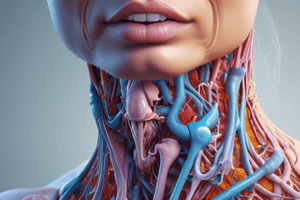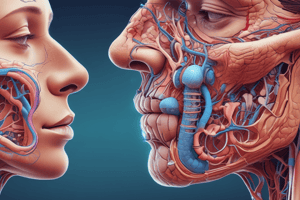Podcast
Questions and Answers
What happens to air when it enters the nasal cavity?
What happens to air when it enters the nasal cavity?
Warms, filters, moistens
What do cilia do?
What do cilia do?
Traps germs and pathogens. Pushes them towards the esophagus
What are cilia?
What are cilia?
Tiny hairlike structures in nasal cavity
What are the 3 sections of pharynx?
What are the 3 sections of pharynx?
How is speech produced?
How is speech produced?
What prevents food and liquids from entering the respiratory tract?
What prevents food and liquids from entering the respiratory tract?
The alveoli contain what rich network of?
The alveoli contain what rich network of?
The allow for exchange between the bloodstream and the lungs.
The allow for exchange between the bloodstream and the lungs.
The inner surfaces of alveoli are covered with a lipid substance called?
The inner surfaces of alveoli are covered with a lipid substance called?
Why is the left lung smaller than the right lung?
Why is the left lung smaller than the right lung?
What is inspiration?
What is inspiration?
What is expiration?
What is expiration?
What is ventilation?
What is ventilation?
What is external respiration?
What is external respiration?
What is internal respiration?
What is internal respiration?
What is cellular respiration?
What is cellular respiration?
What causes the respiratory center in the medulla oblongata of the brain to increase the rate of respirations?
What causes the respiratory center in the medulla oblongata of the brain to increase the rate of respirations?
What is bronchitis?
What is bronchitis?
What is influenza?
What is influenza?
What is sinusitis?
What is sinusitis?
What is emphysema?
What is emphysema?
What is epistaxis?
What is epistaxis?
What is tuberculosis?
What is tuberculosis?
What is asthma?
What is asthma?
What is rhinitis?
What is rhinitis?
What is COPD?
What is COPD?
What is pleurisy?
What is pleurisy?
What is laryngitis?
What is laryngitis?
What does CPAP stand for?
What does CPAP stand for?
What is CPAP used for?
What is CPAP used for?
What is an upper respiratory infection?
What is an upper respiratory infection?
What is crepitation?
What is crepitation?
What is thoracentesis?
What is thoracentesis?
What is pneumonia?
What is pneumonia?
What is obstructive sleep apnea?
What is obstructive sleep apnea?
What is central sleep apnea?
What is central sleep apnea?
What does visceral refer to in relation to the lungs?
What does visceral refer to in relation to the lungs?
How many lobes does the visceral lung have?
How many lobes does the visceral lung have?
What does parietal refer to in relation to the lungs?
What does parietal refer to in relation to the lungs?
How many lobes does the parietal lung have?
How many lobes does the parietal lung have?
Flashcards
Air processing
Air processing
Air is warmed, filtered, and moistened in the nasal cavity.
Cilia
Cilia
Tiny hairlike structures that trap germs in the respiratory tract.
Pharynx sections
Pharynx sections
The pharynx consists of nasopharynx, oropharynx, and laryngopharynx.
Speech production
Speech production
Signup and view all the flashcards
Epiglottis function
Epiglottis function
Signup and view all the flashcards
Alveoli
Alveoli
Signup and view all the flashcards
Surfactant
Surfactant
Signup and view all the flashcards
Left lung size
Left lung size
Signup and view all the flashcards
Inspiration
Inspiration
Signup and view all the flashcards
Expiration
Expiration
Signup and view all the flashcards
Ventilation
Ventilation
Signup and view all the flashcards
External respiration
External respiration
Signup and view all the flashcards
Internal respiration
Internal respiration
Signup and view all the flashcards
Cellular respiration
Cellular respiration
Signup and view all the flashcards
Medulla oblongata
Medulla oblongata
Signup and view all the flashcards
Bronchitis
Bronchitis
Signup and view all the flashcards
Influenza
Influenza
Signup and view all the flashcards
Sinusitis
Sinusitis
Signup and view all the flashcards
Emphysema
Emphysema
Signup and view all the flashcards
Epistaxis
Epistaxis
Signup and view all the flashcards
Tuberculosis
Tuberculosis
Signup and view all the flashcards
Asthma
Asthma
Signup and view all the flashcards
Rhinitis
Rhinitis
Signup and view all the flashcards
COPD
COPD
Signup and view all the flashcards
Pleurisy
Pleurisy
Signup and view all the flashcards
Laryngitis
Laryngitis
Signup and view all the flashcards
CPAP therapy
CPAP therapy
Signup and view all the flashcards
Crepitations
Crepitations
Signup and view all the flashcards
Thoracentesis
Thoracentesis
Signup and view all the flashcards
Pneumonia
Pneumonia
Signup and view all the flashcards
Obstructive sleep apnea
Obstructive sleep apnea
Signup and view all the flashcards
Central sleep apnea
Central sleep apnea
Signup and view all the flashcards
Visceral pleura
Visceral pleura
Signup and view all the flashcards
Parietal pleura
Parietal pleura
Signup and view all the flashcards
Study Notes
Air Processing in the Respiratory System
- Air entering the nasal cavity is warmed, filtered, and moistened.
- Cilia are tiny hairlike structures that trap germs and push them toward the esophagus.
Pharynx Structure
- The pharynx consists of three sections: nasopharynx, oropharynx, and laryngopharynx.
Speech Production
- Speech is produced when air enters the lungs and causes vocal cords to vibrate.
Protective Mechanisms
- The epiglottis prevents food and liquids from entering the respiratory tract.
Alveoli Functionality
- Alveoli contain a rich network of blood capillaries, allowing for gas exchange between the bloodstream and lungs.
- The inner surfaces of alveoli are covered with a lipid substance called surfactant.
Lung Anatomy
- The left lung is smaller than the right lung due to the positioning of the heart on the left side of the chest.
Breathing Processes
- Inspiration refers to the act of breathing in air, while expiration is the act of exhaling.
- Ventilation is the overall process of breathing.
Gas Exchange
- External respiration involves the exchange of oxygen and carbon dioxide between the alveoli and lungs.
- Internal respiration is the exchange of these gases between the bloodstream and body tissues.
Cellular Respiration
- Cellular respiration involves the exchange of oxygen and carbon within cells to produce energy, water, and carbon dioxide.
Respiratory Regulation
- The respiratory center in the medulla oblongata increases the rate of respiration in response to higher carbon levels or lower oxygen levels in the blood.
Common Respiratory Conditions
- Bronchitis is the inflammation of bronchi and bronchioles.
- Influenza is a highly contagious viral infection affecting the respiratory system.
- Sinusitis refers to the inflammation of the mucous membrane lining the sinus.
- Emphysema involves the deterioration of alveolar walls, resulting in loss of elasticity.
- Epistaxis is commonly known as a nosebleed.
- Tuberculosis is an infectious lung disease caused by bacteria.
- Asthma consists of bronchospasms that narrow the openings of the bronchioles.
- Rhinitis is the inflammation of nasal mucous membranes.
- Chronic Obstructive Pulmonary Disease (COPD) includes any chronic lung disease that obstructs airways.
- Pleurisy is the inflammation of the membranes surrounding the lungs.
- Laryngitis is the inflammation of the voice box and vocal cords.
Treatment and Monitoring
- CPAP (Continuous Positive Airway Pressure) therapy uses air pressure to keep airways open and is often used for sleep apnea.
- Upper respiratory infections result in inflammation of the mucous lining of the upper respiratory tract.
- Crepitations are abnormal sounds heard in the lungs.
- Thoracentesis is a procedure to withdraw fluid from the pleural space using a needle.
- Pneumonia is characterized by inflammation or infection of the lungs.
- Obstructive sleep apnea is caused by blockages in the air passages during sleep, while central sleep apnea arises from disorders in the respiratory center of the brain.
Lung Anatomy Details
- The visceral pleura is attached to the surface of the lungs, with three lobes in the right lung.
- The parietal pleura is attached to the chest wall, with two lobes in the left lung.
Studying That Suits You
Use AI to generate personalized quizzes and flashcards to suit your learning preferences.




